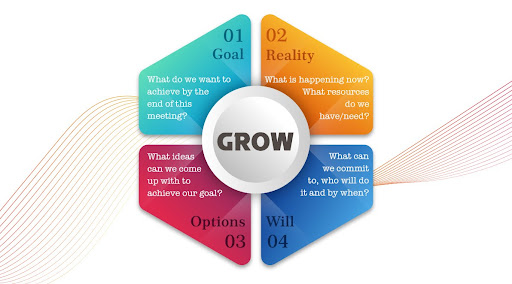
The GROW Model
One of the basic, yet result-yielding models that we use in coaching is the GROW model. I have used other models, yet there is no comparison to this, when it comes to the simplicity of usage.
Now what do I mean by model and why do we use it?
I believe that models are used by coaches as a framework to direct the coaching session. As fellow human beings, we sometimes do tend to get carried away and sway away from the intended outcomes. These models guide the session in an organized manner. They help the coach to guide his client to arrive at the intended goal by the end of the session. These models also are handy, when the client has a lot to share and the time is limited.
You could find tons of material on the GROW model online. This is my take on this model. I have tried to write it best based on my experiences with clients.
What does GROW stand for?
G - Goal
R - Reality
O - Options
W - Way forward
That is all that there is to this model. To best explain the model, a fictitious coach-client session can be utilized.
I have chosen a case of a client, trying to lose weight and a coach who is helping him to explain this model.
After the customary introductions, the coach starts by asking questions that clarify the goal of the session. That is The Goal of the session. The typical questions could be
- What would be the ideal goal that you wish to achieve?
- By When do you wish to achieve it?
- What are the benefits of achieving this goal?
- What will be the goal for this session?
- Do you feel like the goal is achievable?
- How will you know that you have reached the goal of this session?
Once the goal of the session had been established, then the coach would proceed further to the reality. This is a step to bring back and make the client aware of his current situation. Accepting reality will pave way for further discoveries. A few questions to establish this could be
- What is happening right now?
- What are the steps you have taken to lose weight?
- What has worked well for you?
- Have you tried anything different? What happened?
- On a scale of 1-10, 10 being the highest, where are you in relation to your goal?
- What is missing?
- What do you think is required of you?
When the client starts to describe his reality as objectively as possible, there is often a realization with him. He could come up with ideas and routines that will help him achieve his goal. Now all the coach has to do is help list out the options in front of him. The questions that help the client come up with possible options could be
- Of all the possibilities you have explored, what would you like to try?
- What would happen if you go with this new routine?
- What other options would you like to try?
- What is the most difficult part about this option?
- What could you do differently this time?
- How will you find time for this routine?
Once the client understands and accepts the options he has selected, the coach will then find ways to keep him accountable for his actions. This according to me is a very important step, as implementing the changes that the client has decided is critical to his goal. The first action step and the following steps will be decided by the client with the help of the coach.
- What would be your first action step towards achieving your goal?
- How committed are you now, on a scale of 1-10, 10 being the highest, that will follow through the options?
- What could be some possible roadblocks?
- What could you do when you encounter some hindrances?
- Who will help you to stay committed to the activities planned?
- How will you feel if you are unable to follow through with the actions planned?
- What could make this action more fun and engaging for you?
- What would you have to change to accommodate this new option?
With these questions, the coach will hand back the responsibility of seeing through his actions to the client. This was a very brief and kind of bird’s eye view of using the GROW model for a life coaching session.
With my limited knowledge, the only cons I could mention is that there is not much scope for engaging in mindfulness while using this model. A well-experienced coach might be able to do it easily, but for a novice, it would not be easy. The questions are direct and do not give much scope for the client to wander away.
To conclude, I would say , that all these models have been designed to help the coach help the client. I started my journey, adhering strictly to the questions that were proposed in this framework. It gave me confidence , that I could guide my clients. Wishing all coaches, a powerful session with this fundamental yet powerful framework.

